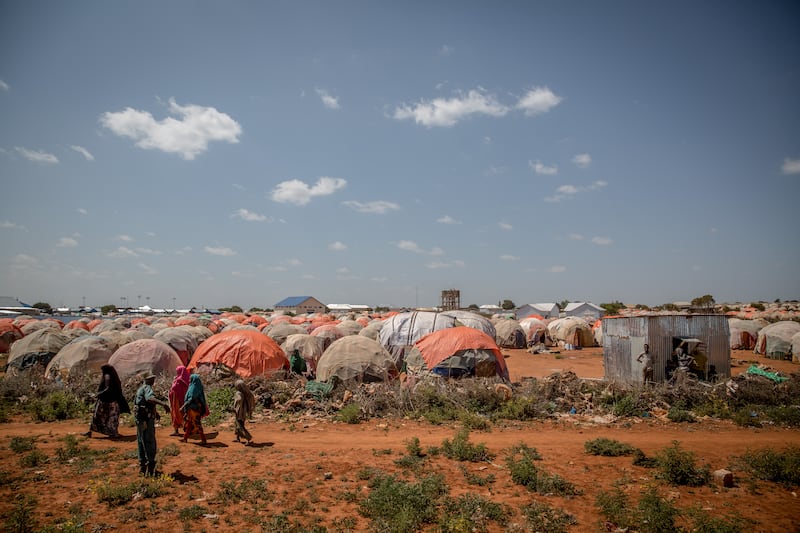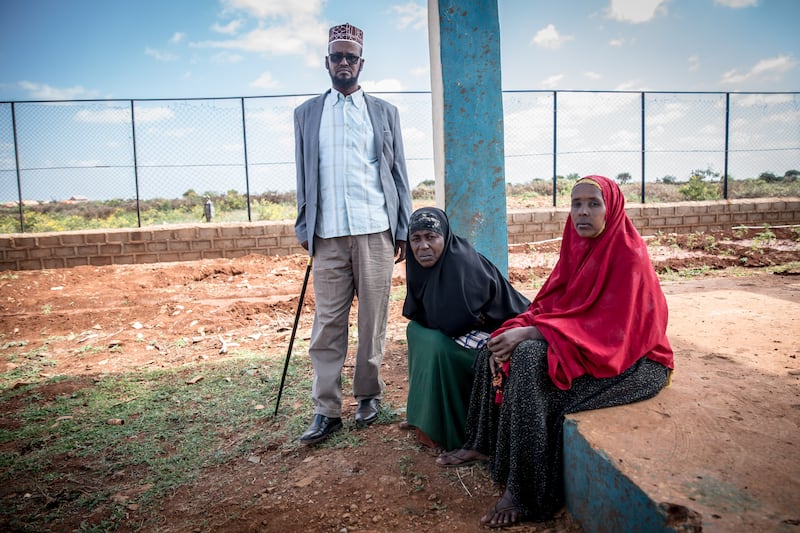Thirty years ago, it was known as the “city of death”. Locals say that during the 1992 famine, between 100 and 250 people were dying each day in Baidoa, in Somalia’s South West State. Their bodies would be left on the roads where they fell, or picked up by trucks and buried in mass graves. One third of the town’s population are said to have starved to death within three months, as civil war raged around them.
Today, Baidoa is a much larger city. But it is battling another hunger crisis, as Somalia goes through its fifth failed rainy season in a row. And there is a new enemy: the al Qaeda-linked Islamic militant group Al Shabaab.
During an interview in a guest house in central Baidoa, Dini Abdi Noor, director general for the South West State branch of Somalia’s ministry of humanitarian affairs and disaster management, said the city is surrounded on all sides by fighters of Al Shabaab, the al-Qaeda affiliate which controls large swathes of Somalia’s territory. The fighters are situated roughly 20km in any direction (other sources suggest there may be one safe road into the city).
Despite this, Baidoa, once known as the region’s breadbasket, is again an epicentre of the drought response. In recent years, hundreds of thousands of displaced people have flocked there. While some come temporarily, such as during the 2017 drought, others stay long term, saying they have nothing to go back to.
Government officials say the population of the city has swelled from roughly 500,000 people. They give figures of between 160,000 and 300,000 as the number of displaced people believed to have arrived since the latest drought began. According to UN data, 108,000 people have come to Baidoa specifically since the beginning of 2022, with more than 16,000 arriving in the last month alone.

Flying into Baidoa today, it is easy to see the camps those people end up in, which stretch out beyond the city. They build buuls – small round shelters, constructed from sticks and fabric – their bright coverings visible from the sky.
Many made the decision to come after hearing that international aid agencies are distributing relief, but when they arrive they realise it is not enough. “They come here with high expectations,” said Noor.
They bring little but the clothes they are wearing. In interviews, displaced people describe the animals they used to own: cows, goats, camels – which have died from hunger or thirst. They survive by begging, or wandering around the city, trying to find odd jobs, like cleaning and washing clothes.
Noor, who worked for Médecins Sans Frontières (MSF) during the 1992 famine, said responding to the current drought is harder in some ways than the last famine in 2011, or the 2017 drought. “Access was better last time,” he said, referring to the close presence of Al Shabaab and the security problems that poses. “This time we cannot move.” The lack of safe roads from port capital Mogadishu mean that aid is regularly flown in, rather than driven.
Different displacement camps in Baidoa have different services available, and far more that are lacking. About 1,800 people live in Wadajir 4, in the Hanano zone. There is water, but there are barely any toilets, said Kaltuma Aden, who is on the local water committee. The 37-year-old has been in Baidoa for five years, and has nine children. She explains how each family gets a ration of up to 10 jerrycans of water a day.
“The problem now is the toilets. The latrines are filled up, people are overusing, there is no waste management, not enough soap.” She said there are fewer than 10 functional toilets for everyone.
Hunger is also a constant. “There is severe food insecurity,” she said. “People go out to collect firewood, women go to wash clothes in the host community but it’s not a reliable income.”
She said children die regularly. “Those who died were not taken to hospital, [because their families] don’t have [money for] transport, they don’t have someone to mind the other children.”
And more people arrive every day.
“They are not engaged in any productive activity, they are just here waiting for relief. And this congestion also spreads disease,” said a local humanitarian worker.

In the nearby Hanano 2 mother and child health clinic, which is supported by Irish aid organisation Concern Worldwide, roughly 30 severely malnourished children are admitted for treatment each day, said nurse Idil Abdi.
“[The situation] is deteriorating seriously from previous months,” said Abdi. “[There’s a] measles outbreak, malaria endemic, influenza, and more arrivals.”
Measles, particularly, has proved a killer for malnourished children. “There’s a serious outbreak of the measles. We’re trying to refer and manage the cases but it’s hard,” she said.
One of the clinic’s attendees, Zaineb Madjinay, bobbed a sneezing baby on her lap, as she explained that she’s lived in a camp called Tuug Soy for the last seven months. Roughly 2,400 others live there too.
“In terms of security it’s okay and people are trying to support each other, but there’s no humanitarian support,” she said.
Madjinay fled from Rama Addey, 75km away. Al Shabaab were carrying out forced recruitment, but that wasn’t her reason for getting out. “I came here because of hunger. I had animals and a small farm: everything was lost. I was keeping goats and cattle but they died,” she said.
Humanitarian response
Richard Nunn, Concern Worldwide’s programme director, said the humanitarian response has been underfunded so far, and there have been some issues with co-ordination.
The money that comes through to organisations like his is often only pledged in three-month bursts, he said, meaning it is not possible to scale up the response in a meaningful way. Displaced people also complained that any help they were getting, including cash transfers, had only been given short-term, leaving them desperate again once it ended. What has been done is a drop in the ocean compared to what is required, many local leaders, displaced people, and aid workers seem to agree.

The latest report by the Integrated Food Security Phase Classification (IPC), which describes the severity of food emergencies, was released earlier this month. Though it did not declare a famine, one is projected in certain areas of Somalia between April and June next year, including among internally displaced people in Baidoa and in capital city Mogadishu. Even without the declaration, more than 200,000 Somalis are already thought to be experiencing “catastrophe” levels of food insecurity – the most severe level.
Daniel Molla, who is part of the core team making assessments for the IPC, says the famine mortality threshold regarding the number of children dying of starvation-related causes has already been reached among displaced people in Baidoa, with more than four children per 10,000 dying every day.
Malnourished children
Despite the widespread and obvious hunger, Dr Abdullahi Yusif, the medical co-ordinator at Baidoa’s Bay Regional Hospital, said the number of malnourished children being admitted to their eight-year-old stabilisation centre has gone down this month. He wondered if it was because people were accessing food distributions or because those in urgent need were struggling to make it to hospital at all.
The hospital is one of the oldest in the region. It provides free healthcare, mostly taking the sickest patients through referrals, Yusif explained.
One third of the 120 beds for the stabilisation of malnourished children are currently being used. There are also about 20 isolated child measles cases, many of whom are also likely to be malnourished, he said.

Inside the stabilisation ward was Fadumo Manur. She sat by her two-and-a-half year-old boy, who recently had whooping cough and the measles. He was admitted four days before, weighing 6.7kg. Now he weighs 7kg, she said with some relief. According to the World Health Organisation’s child growth standards, a healthy child of his age should ideally weigh almost double that.
Manur travelled 15km to get to the hospital. She said her family has been struggling to get enough food to eat for a long time. “For two years there has been nothing to harvest,” Manur explained.
Sitting nearby was Shukri Maalim Ali, whose two-year-old was recovering from measles and malnutrition.
“He was vomiting and coughing. Now he’s feeling a bit better,” Ali said. She walked with him to the hospital, along with a younger child she is still breastfeeding. Two others are still at home, but they’re also sick. “It’s very difficult to get food.”
Ali has tried to sign up for an aid programme that distributes cash to displaced people like her, but she hasn’t received anything yet. “Basic needs are not available,” she said.
Famine memories
Adan Hassan, the deputy governor for humanitarian affairs of the Bay region, where Baidoa is located, said this area is always badly affected by drought. As many as 70 per cent of residents are farmers or support themselves through their livestock, so they are reliant on rain. “Livestock died because of lack of water, lack of anything ... So [the people] come to the cities. They can’t live without animals, they can’t live without farm produce,” he said.
Hassan was a child at the time of the 1992 famine, which is said to have killed hundreds of thousands of people. “Drought and conflict was there at that time and the Somali state was collapsed. [There was] civil war. No place to run. No food, no water. The combination caused many people to die,” he recalled.
Hassan lived 40km away, in a village, at that time. “You saw some people die in front of you and there’s nothing you can do ... Many people remember that, they were shocked or affected, maybe their parents died, their children, their sisters and brothers ... You say this will never come again, but this is the world, you meet many things.”
Today, he estimates that about 40 per cent of displaced people are getting some kind of help, “but not enough”. There are gaps, including in providing sanitation and healthcare. “The cleanness of children [is] so bad ... clear water, medicines for specific children ... a lot don’t have any energy.”
“We are not afraid of a famine,” continued Hassan, optimistically, saying he hopes a harvest will come soon. “If you’ve got something to eat the farmers don’t have to go to the cities.” Other officials disputed that any possible harvest will be significant enough to make much of a difference in the coming months.

Hassan, like other government officials I interviewed, also expressed the desire that international donors focus more on development projects, rather than just on an emergency response to the drought. In a sign of the importance authorities attach to development , vehicles spouting water could be spotted about the city where roads were being tarmacked, despite the significant water shortages.
“Baidoa’s people need many things. They also need development, also need infrastructure,” said Hassan. “We hope to go from humanitarian aid to development. I hope in the future Baidoa will be bigger: more buildings, roads, infrastructure, so our future may be better.” He said he would like the city to earn the name “beautiful Baidoa”.





















